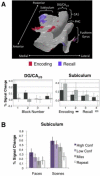Imaging the human medial temporal lobe with high-resolution fMRI
- PMID: 20159444
- PMCID: PMC2844113
- DOI: 10.1016/j.neuron.2009.12.022
Imaging the human medial temporal lobe with high-resolution fMRI
Abstract
High-resolution functional MRI (hr-fMRI) affords unique leverage on the functional properties of human medial temporal lobe (MTL) substructures. We review initial hr-fMRI efforts to delineate (1) encoding and retrieval processes within the hippocampal circuit, (2) hippocampal subfield contributions to pattern separation and pattern completion, and (3) the representational capabilities of distinct MTL subregions. Extant data reveal functional heterogeneity within human MTL and highlight the promise of hr-fMRI for bridging human, animal, and computational approaches to understanding MTL function.
Copyright 2010 Elsevier Inc. All rights reserved.
Figures




References
-
- Bar M, Aminoff E. Cortical analysis of visual context. Neuron. 2003;38:347–358. - PubMed
-
- Bellgowan PS, Bandettini PA, van Gelderen P, Martin A, Bodurka J. Improved BOLD detection in the medial temporal region using parallel imaging and voxel volume reduction. Neuroimage. 2006;29:1244–1251. - PubMed
-
- Bird CM, Burgess N. The hippocampus and memory: insights from spatial processing. Nat Rev Neurosci. 2008;9:182–194. - PubMed
Publication types
MeSH terms
Substances
Grants and funding
LinkOut - more resources
Full Text Sources
Other Literature Sources
Medical

